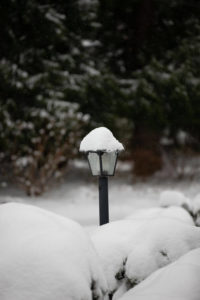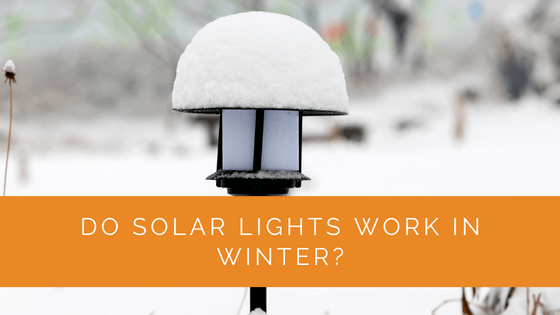Winter is upon us again. As the temperatures start dropping outside, the concerns of rising electricity bills begin to loom. In the winter, the temperatures hover around 3°–4° C in the UK. So, it isn’t easy to survive without heating devices, drastically increasing the electric bill.
That’s the reason why solar power is becoming a popular choice. Some people have started using solar lights to illuminate their gardens and porches. And many are switching to it and want to turn to more environmentally friendly alternatives to electricity.
But the primary concern is – do solar lights work in winter? The short answer is yes. The solar lights work effectively in winter. How?
Read on to know more about how it’s possible and what you can do to ensure your solar lights get enough sunlight in winter. However, before unravelling the secrets, it’s essential to understand how solar lights work.
The Quick Answer
Solar lights work during winter as long as they receive ample sunlight for 3 to 5 hours daily. While direct sunlight offers the best settings to make the solar lights work, other alternatives exist to charge the solar batteries.
Contents
- 1 Key Takeaways
- 2 Understanding How Solar Lights Function
- 3 What Type of Solar Lights Work Best in the Winter?
- 4 Tips to Charge Solar Lights in Winters
- 5 Case Study: Optimising Solar Lights for Winter Conditions
- 6 Expert Insights From Our Solar Panel Installers About Solar Lights in Winter
- 7 Our Expertise in Solar Lights
- 8 Parting Thoughts
Key Takeaways
- Solar lights can indeed work effectively during winter, provided they receive about 3 to 5 hours of sunlight daily.
- To optimise the performance of solar lights in winter, it’s crucial to keep the solar panels clean and free of snow, avoid shading, adjust the panel angle, and position them facing south.
- Various types of solar lights, including garden lights, string lights, wall lights, and security lights, are available for different purposes, and their efficiency in winter may vary but can be improved with proper care.
Understanding How Solar Lights Function
Solar lighting is an effective solution to reduce the carbon footprint on the planet. It is a dependable renewable energy source and is available everywhere. However, people hesitate to adopt solar energy entirely in cold temperatures where sunlight is not as bright and is abundant daily.
So, how does it work in winter? Can you do something to get the best out of solar lighting in winter?
The working of solar-powered lights is pretty simple. Solar lights have four primary gears – a solar panel, a photoreceptor, batteries, and a light bulb. The solar panel produces energy during the day using photovoltaic cells. The energy gets stored in the batteries. The photoreceptors activate the light bulb with the stored energy when it detects darkness or no sunlight.
What Type of Solar Lights Work Best in the Winter?
The popularity of solar lights has led to a vast array of choices in the market. You may find different kinds of solar lights when shopping. But does any solar light work better than the other in winter? Let’s first peek at the type of solar lights available.
There are two categories of solar lights:
- Outdoor solar light
- Indoor solar light
Outdoor solar lights are also available in different types; depending on the purpose, you can pick any.
Solar Garden Lights
For brightening your outer space, outdoor-rated solar lights are your best bet. The most popular choice is solar garden lights. Different garden lighting options can completely light your garden without swelling your electric bill.

Solar String Lights or Fairy Lights
Solar string lights are energy-efficient lights to fulfil your decorative needs. You can use them to illuminate the outdoor space at home or work, even indoors. Wrap the solar string lights around trees, branches, or shrubs to add a distinct look to them.
Since it has lights arranged on a string, you can use them as Christmas or solar fairy lights.
Wall Lights
Solar wall lights are another solar lighting system to lighten your outdoors. These lights are available with intelligent energy-saving modes along with motion sensors.
Solar Security Lights or Flood Lights
If you’re looking to install an outdoor lighting system for safety, there is no better option than solar security lights or flood lights. You can fit these lights in any place with more darkness, like around the house, backyard, parking lots, driveways, streets, etc.
All solar lights can work in winter with low sunlight. However, their efficiency may not be up to the mark. But we have some tips for you.
Tips to Charge Solar Lights in Winters
Contrary to popular belief, solar lights do work in winter. But less sunlight can hamper the performance of the lights. So, if you want to get the best out of solar lights, here are some tips to make them work in winter, too. To optimise solar energy production:
Keep Them Pristine
Keeping the solar panels clean and dirt and snow-free is one of the easiest ways to get the best out of solar lights. The grime and snow on the panels block the sun’s rays from reaching them. Some studies reveal that snow can reduce the performance of solar lights by up to 15%.
Avoid Shadows
During winter, when the sunlight is already less, shadows can even block the little sunshine panels are getting. So, remove all the obstacles or objects that cast shadows over the solar panels. You may need to relocate the panels to avoid this issue.
Place at An Angle of 60 °
Solar panels perform best when placed directly vertically to the sun’s rays. Many manufacturers recommend positioning your solar panels at 30°. For the best results in winter, reposition them at 60° if they are tiltable and can be adjusted.
Positioning Facing South
Solar panels might face more shadows because the days are shorter than nights in winter. Try positioning them in the south direction to ensure it doesn’t happen. It will allow more sunlight to reach your solar panels in cold temperatures.
Case Study: Optimising Solar Lights for Winter Conditions
Background
A family living in a suburban home wanted to illuminate their garden and driveway during the winter months using solar lights. The primary concern was whether solar lights would be effective during winter when daylight hours are shorter and sunlight intensity is lower. The family sought a solution that would provide consistent lighting despite these challenges.
Project Overview
The project aimed to install solar lights that could function efficiently throughout the winter. The focus was on maximising energy capture during limited sunlight hours and ensuring the lights provided adequate illumination after sunset. The installation included a combination of solar garden lights, string lights, and security lights to meet different lighting needs around the property.
Implementation
- Assessment and Planning: The project began with a comprehensive assessment of the property, focusing on identifying the best locations for solar lights to receive maximum sunlight. The assessment considered factors such as shading from trees, buildings, and other obstacles.
- Selection of Solar Lights and Installation Techniques:
- Choosing the Right Lights: The family selected high-quality solar garden lights, string lights for decorative purposes, and security lights for enhanced safety. These lights were chosen for their high lumen output and efficiency in low-light conditions.
- Optimal Placement and Panel Angling: To maximise sunlight exposure, the solar panels were positioned at a steeper angle (around 60°) and faced south to capture the most sunlight during winter. This setup was essential for compensating for the lower sun angle and shorter days.
- Regular Maintenance Plan: The family was advised to keep the panels clean and free from snow and debris. A regular maintenance schedule was established, including periodic checks and cleaning to ensure optimal performance.
Results
The solar lights provided reliable illumination throughout the winter. The garden and driveway were well-lit, enhancing the home’s aesthetics and security. The family reported that the lights worked efficiently, even on days with limited sunlight, thanks to the strategic positioning and regular maintenance. The installation met the family’s needs for environmentally friendly and cost-effective lighting, reducing their reliance on grid electricity.
Summary
Solar lights can be an effective solution for outdoor lighting during winter, provided they are installed and maintained correctly. This case study demonstrates the importance of strategic positioning, regular maintenance, and selecting high-quality solar lights to ensure efficient performance during shorter, less sunny days. At Solar Panels Network, we specialise in providing tailored solar solutions, helping homeowners make the most of renewable energy sources year-round.
Solar lights can effectively illuminate outdoor spaces even in winter conditions with the right approach. This case study highlights the critical factors in optimising solar lights’ performance during the winter months, ensuring they provide reliable and efficient lighting for gardens, driveways, and other outdoor areas.
Expert Insights From Our Solar Panel Installers About Solar Lights in Winter
Solar lights can work effectively in winter, provided they receive enough sunlight. It’s crucial to position the panels properly and keep them clean to maximise energy absorption during shorter daylight hours.
Lead Solar Technician
Winter conditions can affect solar lights’ performance, but with the right setup, such as tilting panels at a steeper angle and positioning them south-facing, you can still achieve good illumination.
Renewable Energy Specialist
Maintenance is key during the winter months. Regularly checking and cleaning your solar panels ensures that they operate efficiently, even when sunlight is limited.
Solar Product Consultant
Our Expertise in Solar Lights
At Solar Panels Network, we’re here to provide you with valuable information and support regarding solar lighting. With our experience and understanding of the solar lighting industry, our team of experts is prepared to assist you in finding the right lighting solution for your needs. Whether you’re interested in improving your outdoor spaces, conserving energy, or adopting a more sustainable approach, we’re well-equipped to help. Please feel free to contact us with any questions or inquiries.
Parting Thoughts
There you go! Solar lights work during winter as long as they receive ample sunlight for 3 to 5 hours daily. While direct sunlight offers the best settings to make the solar lights work, other alternatives exist to charge the solar batteries.
Ensure using high-quality solar lights for best results. Check the manufacturer’s guidelines on the packaging. See the lowest temperature they can perform. Note how long they need to charge and if they are outdoor-rated. It will help you pick the best solar panel lights.
About the Author
Solar Panels Network stands at the forefront of solar energy solutions, driven by a team of seasoned solar engineers and energy consultants. With over decades of experience in delivering high-quality solar installations and maintenance, we are committed to promoting sustainable energy through customer-centric, tailored solutions. Our articles reflect this commitment, crafted collaboratively by experts to provide accurate, up-to-date insights into solar technology, ensuring our readers are well-informed and empowered in their solar energy decisions.

